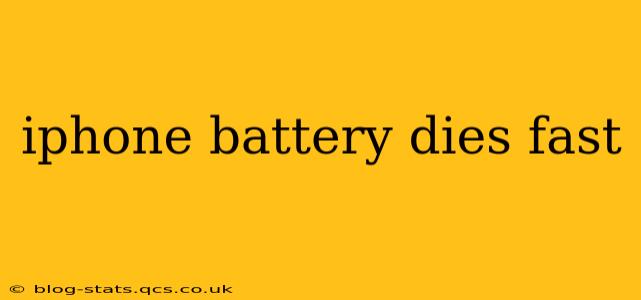Is your iPhone battery draining faster than it used to? It's a frustrating problem, but thankfully, there are several things you can do to diagnose and fix the issue. This comprehensive guide will walk you through the common causes of rapid battery drain and offer effective solutions. We'll explore everything from simple software tweaks to potential hardware problems.
Why is My iPhone Battery Draining So Quickly?
This is the most common question we hear from iPhone users experiencing rapid battery depletion. Several factors can contribute to this issue:
-
Background App Activity: Many apps continue running in the background, consuming battery power even when you're not actively using them. Location services, data syncing, and push notifications all contribute to this drain.
-
Screen Brightness: A consistently bright screen is a major battery hog. Keeping your screen brightness at a reasonable level can significantly extend battery life.
-
Low-Power Mode: This built-in iOS feature restricts certain background activities to conserve battery. Activating Low Power Mode can significantly improve battery performance when needed.
-
Outdated Software: Older iOS versions may contain bugs that impact battery performance. Keeping your iPhone updated to the latest iOS version is crucial.
-
Hardware Issues: In some cases, a failing battery or other internal hardware component can lead to rapid battery drain.
-
Faulty Apps: A buggy or poorly optimized app can drain your battery significantly more than others.
How Do I Fix My iPhone Battery Draining Problem?
Let's delve into the solutions for each of the common causes:
1. Manage Background App Activity:
-
Close Unused Apps: Regularly close apps you're not using. Double-click the home button (or swipe up from the bottom on newer models) to view recently used apps and swipe up to close them.
-
Limit Background App Refresh: Go to Settings > General > Background App Refresh and disable it for apps you don't need to update constantly. You can also choose to limit it to Wi-Fi only.
-
Location Services: Go to Settings > Privacy & Security > Location Services and restrict location access for apps that don't require it. Consider using "While Using the App" instead of "Always".
2. Adjust Screen Brightness:
-
Reduce Brightness: Manually lower your screen brightness. You can do this by using the brightness slider in Control Center or within the Settings > Display & Brightness menu.
-
Enable Auto-Brightness: Let your iPhone automatically adjust screen brightness based on ambient light. Go to Settings > Display & Brightness > Auto-Brightness and turn it on.
3. Utilize Low Power Mode:
This is a quick and easy way to extend your battery life. Activate it by going to Settings > Battery and toggling the Low Power Mode switch on. Your iPhone will provide you with a visual indicator while Low Power Mode is enabled.
4. Update Your iPhone Software:
Regularly check for and install iOS updates. Apple often releases updates that include battery performance improvements and bug fixes. Go to Settings > General > Software Update to check for updates.
5. Identify and Address Faulty Apps:
If you suspect a particular app is causing the problem, try uninstalling it temporarily to see if it improves battery performance. If it does, consider looking for alternative apps or contacting the app developer. You can monitor battery usage by going to Settings > Battery. This screen shows you which apps have used the most battery recently.
6. Consider Hardware Issues:
If none of the above steps resolve the issue, your iPhone might have a hardware problem. This could be a failing battery, damaged charging port, or other internal component. Contact Apple Support or an authorized service provider for diagnosis and repair. A swollen battery is a serious issue and should be addressed immediately.
7. Reset All Settings:
As a last resort, consider resetting all settings on your iPhone. This will reset all your customized settings to their default values, which can sometimes resolve hidden software conflicts affecting battery life. Important: This will not delete your data, only your settings. Go to Settings > General > Transfer or Reset iPhone > Reset > Reset All Settings.
Frequently Asked Questions (FAQs)
These are common questions people ask about fast-draining iPhone batteries:
How long should an iPhone battery last?
The lifespan of an iPhone battery varies depending on usage, but you should generally expect a full day's use on a single charge with moderate to heavy use. Apple provides estimates based on typical usage scenarios on its website.
Does turning off my iPhone completely help extend battery life?
Yes, turning off your iPhone completely periodically can give it a "fresh start" and prevent minor software issues from draining the battery.
Can a damaged charging cable cause my iPhone battery to drain quickly?
A damaged or faulty charging cable can prevent proper charging and even contribute to faster battery drain, so make sure yours is in good condition.
What is battery health and how does it impact my iPhone's battery life?
Battery health, found in the Settings > Battery > Battery Health & Charging menu, indicates the overall performance capability of your battery. A lower percentage means your battery is less capable of holding a charge. Apple provides information on battery health and replacement options.
Is there a way to test my iPhone battery health independently?
Third-party apps may offer battery health checks, but their accuracy can vary, so relying on the official Apple battery health report is usually recommended.
By systematically addressing these potential problems, you should be able to identify the root cause of your iPhone's fast battery drain and restore its optimal performance. Remember, preventing excessive battery drain is a proactive process. Regularly review your app usage, adjust settings as needed, and maintain your device's software to keep your iPhone running smoothly for longer.
